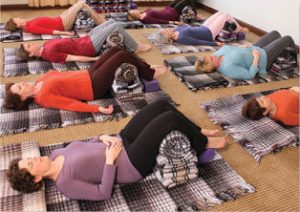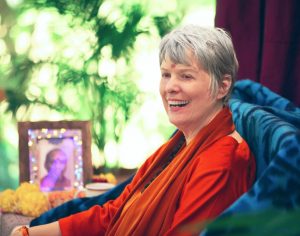Let’s explore how a yogi deals with feelings. The world of feelings is complex and confusing. However, without feelings, there is no real juice in life.
Recognize many different things are meant by one word, “feeling.” It includes physical sensations, as well as emotions. Also, it can refer to intuitive perceptions about people or situations outside of you (like knowing when someone is thinking of you), or subtle perceptions of the vast inner realms of consciousness (like sensing your own immortality). There are many levels of feeling, from physical to subtle, and they are all important.
The yoga texts of Kashmiri Shaivism describe 36 tattvas, beginning with the expansive reality that existed before the Big Bang, named Shiva. This shows how consciousness contracts into all that exists, becoming the universe while still being greater. Shiva also manifests the three levels of your mind, as well as inspiration, desire, your sense of mortality and your sense of immortality.
About halfway between the infinite and the finite are listed the ten senses. These include the five familiar senses (organs of perception), as well as five organs of action. “Feeling” is one of the organs of perception. It is your ability to experience “sensations,” a broadly inclusive term. This ability to feel sensations gets concentrated in your physical body, but exists at a more subtle level as well.
 At the physical level, you move your body around in order to have different sensory experiences. You experience the subtle level in your dreams, where you feel sensations without your body going anywhere or doing anything. The subtle level is just as real as the physical. In addition, the subtle levels of mind and emotions affect you; you have already proved to yourself that you can think yourself into exhaustion.
At the physical level, you move your body around in order to have different sensory experiences. You experience the subtle level in your dreams, where you feel sensations without your body going anywhere or doing anything. The subtle level is just as real as the physical. In addition, the subtle levels of mind and emotions affect you; you have already proved to yourself that you can think yourself into exhaustion.
The perception of “feeling” is related to the organ of action called “handling.” Handling includes your ability to use your hands as well as to handle the situations and people in your life. The relationship between these two — feeling and handling — means that, when your ability to feel physical sensation is diminished, your ability to handle your life will be similarly diminished.
Many people have numbed out their ability to feel their physical body. The tightest areas in your body are also where you have diminished perception. Right now, you may be protesting that you have an area of chronic pain — but, check it out, the same spot on the other side of your body does not hurt. The side that does NOT hurt is actually tighter than the side that does hurt, but it is numbed out so you cannot feel it at all.
 Of course, in Svaroopa® yoga we release the multiple layers of tension by beginning at your tailbone and opening your spine in sequence. As the tensions in your body begin to release, you enjoy a new flexibility and spaciousness in your body. You can feel your body when it is not hurting, and when you are not pushing or straining it. It is a wonderful, even blissful, sensation of your own tangible physical existence.
Of course, in Svaroopa® yoga we release the multiple layers of tension by beginning at your tailbone and opening your spine in sequence. As the tensions in your body begin to release, you enjoy a new flexibility and spaciousness in your body. You can feel your body when it is not hurting, and when you are not pushing or straining it. It is a wonderful, even blissful, sensation of your own tangible physical existence.
Without being able to feel, you are not fully alive. Your body may be like a walking corpse — already stiff and numb before its time. As Svaroopa® yoga opens up your body again, you become more fully alive. You also begin to be able to feel more than just physical sensations. It is impossible to work with the body without dealing with emotions. You must feel. Yoga says you must feel without getting lost in your feelings.
Every emotion is a physical sensation. You can see why some people will shut down their body, so they won’t have to feel their emotions. When you shut down your body and the emotions, you avoid feeling anger and fear. You escape the experience of despair, sadness, blame and guilt. But you also cannot feel genuine happiness, which is a full-bodied experience. You miss out on generosity, compassion, creativity, hope and delight. There is no feeling of inner peace or fulfillment, because there is no “feeling” at all.
Detachment is not the answer. You already know how to withdraw and distance yourself from others. You even know how to withdraw and split yourself off from yourself, unfortunately. This is not yoga, and it is not yoga’s meaning of the word, “detachment.” You must feel. You must feel without getting lost in your feelings.
 We train you in how to feel in every class. Svaroopa® yoga is not a “performance yoga.” It is “consciousness-yoga.” While we begin with your body, we train you in awareness. Shavasana, the Relaxation Pose at the beginning of class, begins with, “Become aware of your toes…” Listen closely next time. It is not a Guided Relaxation; it is a Guided Awareness. After you do the poses and open up the tight places — to redeem/re-enter/re-enliven your body — we take you back to being aware of it again. This is a very powerful training that increases your ability to use this organ of perception, “feeling.”
We train you in how to feel in every class. Svaroopa® yoga is not a “performance yoga.” It is “consciousness-yoga.” While we begin with your body, we train you in awareness. Shavasana, the Relaxation Pose at the beginning of class, begins with, “Become aware of your toes…” Listen closely next time. It is not a Guided Relaxation; it is a Guided Awareness. After you do the poses and open up the tight places — to redeem/re-enter/re-enliven your body — we take you back to being aware of it again. This is a very powerful training that increases your ability to use this organ of perception, “feeling.”
I know that getting into your feelings can be scary. It is too easy to get lost in them, just like if you were lost in the woods. There are a few things that can help you — you can practice the yoga of emotions:
- Stay in the feeling. Don’t shut it down, and don’t act on it. This is the hardest thing of all — keep feeling it but don’t act on it. Don’t even put words to it. Stay in the feeling of it. It is physical — it may be raw. Stay with it.
- Recognize that it is a feeling — it is not who you are. You are having the feeling; you have NOT become the feeling. You can even name the feeling to yourself, “I am feeling anger.” Don’t say, “I am angry.” Your true “I” is much bigger than the temporary experience of anger — no matter how big the anger is.
- Identify the desire hidden inside the feeling. Every unpleasant emotion has a desire hidden in it. If you are angry, you are reacting because you wanted things to go a different way. If you are sad, you are reacting because you wanted things to go a different way. If you are blaming someone for something, you are reacting because you wanted things to go a different way. Do you notice the pattern yet? Every single feeling comes from a desire that things be different than they really are. Identify the desire and name it.
- Now, give up the desire. Spend a few minutes with this one. Don’t rush it. You might decide to notice that your desire isn’t being fulfilled. You are in the middle of a feeling that wants to completely take over because, and only because, you haven’t accepted that things are actually the way they are. You are rejecting reality — except reality isn’t changing to accommodate you. So, just get real. Accept that the situation is the way it really is. And, for at least the moment, give up the desire that it be different. You can always decide later if you will work toward changing it. Your ability to be effective will be significantly enhanced by giving up the desire that fuels your emotion. Just give up the desire hidden within the feeling.
- Now, it is possible that you will find fear hidden under the desire. If so, acknowledge the fear. You might choose to speak the truth about your fear and vulnerability, or you might not. The emotion that started the whole thing is already gone — and the person you are speaking to may be able to hear the truth of your fear, and may even be compassionate or helpful. Of course, not everyone you know will respond this way, so you have to be intelligent about who you share this level of your feelings with.
- Fear is also just a feeling. If you stay with it, don’t push it away — it dissolves. I guarantee it.
 I know that these things are not easy, but they are essential. You will have no life at all unless you do this work — peeling the layers. If you decide to do this “yoga of emotions,” there is an increasing subtlety and beauty that opens up inside as you begin to be able to feel.
I know that these things are not easy, but they are essential. You will have no life at all unless you do this work — peeling the layers. If you decide to do this “yoga of emotions,” there is an increasing subtlety and beauty that opens up inside as you begin to be able to feel.
- Feelings as Physical Sensation — your body becomes progressively more open, less painful and more blissful as your ability to feel it improves.
- Feelings as Emotions — you become able to live in the moment, feeling the range of human experience without getting caught up in desire, knowing yourself as something much greater than your emotions. A deeper quality of peace begins to support you and spread through all your relationships.
- Feelings as Intuition — subtle perceptions begin to show you a deeper level of what is happening around you, and you begin to read the situations and find the answers more easily. After a while at this level, you realize that desire still plays too strong a part and you give up this subtle form of “fortune telling.”
- Feelings as Subtle Knowing — you begin holding consciousness within you, supported by a continuous all-pervasive inner sense of knowingness and beingness. Desire has no hold on you anymore, because the inner feeling is so fulfilling that you would not want to give it up for any external desire.
- Feelings as Vastness and Ecstatic Reality — the progressive inner melting into consciousness becomes a sweet surrender, and continues expanding without end, described clearly in the yoga texts. Now you can live your life in the midst of the world, recognizing it all as the manifestation of Shiva.
You can decide how far you want to go, or when you want to get lost again. Do more yoga.
OM svaroopa svasvabhava.h namo nama.h
